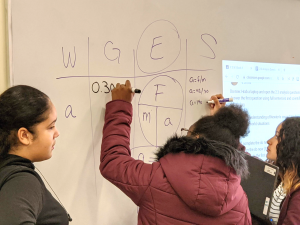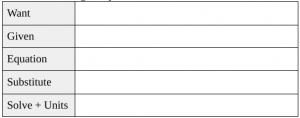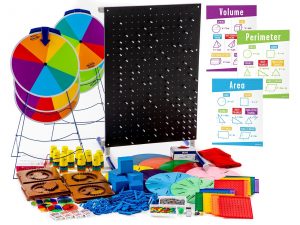I remember early in my teaching career I had the notion that scaffolds in math were a “crutch” that made students skip the “essential pieces” of algebra, trigonometry, or problem-solving. I thought, like many of my colleagues did, that the way I was teaching (i.e. the way described in the textbook I chose) was the best and only way to utilize that math skill. As I’ve grown as an educator, I’ve realized how by thinking that, I’ve prevented students from accessing math. I was not meeting my students where they were. Instead, I was essentially saying, “my way or the highway.” In actuality, most of the math we teach is tricks!

There are hundreds of different ways to multiply and divide. Think of the backlash “new math” got from parents and teachers alike because it was new and different. It is our job to give students multiple access points to learn math. They should then be able to choose the scaffold that works best for them. In a time where students across the U.S. are falling behind in math, we should be opening the points of access, not closing them. In this piece I’ll be showing some access points I use in my classroom that help make math more accessible.
Let Students Use a Calculator
First, students should always be able to use a calculator. Yes, I said always. Remember when we were in school and our math teachers said, “you’ll never have a calculator in your pocket?” Well, the joke is on them! Technology has made it so students always have access to a basic calculator on their phones, and the apps are getting more advanced every year. This means we need to ensure that our students are calculator proficient. The ability to utilize the tool in their pocket is vital to real-world math skills. I actually give my students the option to use the calculator on their phone for assignments so that they get used to using it. They’re not going to have access to whatever TI solar-powered calculator I have in my classroom in the real world, but they will have their cell phone the next time they need to calculate the sale price of a bag of chips at the corner store.
Problem-Solving Scaffold
Another tool I utilize is a problem-solving scaffold. This can be useful for students to break down word problems into solvable parts. The key is for the science and math teachers to communicate, and the goal is to use the same one in both classes and all grades so students can utilize it beyond your classroom. This is not a new notion and can really aid students in problem-solving beyond the classroom. There are many different scaffolds you can use. I use Want, Given, Equation, Solve + Units (WGES+U), but others use List, Equation, Substitute, Solve (LESS), or others. You can even make one with your students so that it is easier for them to remember!

One problem students have at the high school level is isolating variables. Formula circles or triangles can aid beginner algebra students in variable isolation. I even have my students create their own, instead of providing the circles for them. This actually enforces the algebraic reasoning for my visual learners and aids in the acquisition of the skill. I also ensure that I also show the classic algebraic steps so students have multiple access points for this skill.

In the end, it is our job as teachers to make our material accessible to our students, not the other way around. Scaffolds are an incredible tool to ensure a traditionally exclusionary subject like math is accessible for all students. After all, we need math-literate members of our society. Pick one of these, or another scaffold, and to add it to your lesson this month. You’ve got this!
Looking for tangible math tools? Check out our selection of hands-on math manipulatives and activities.








Leave A Comment